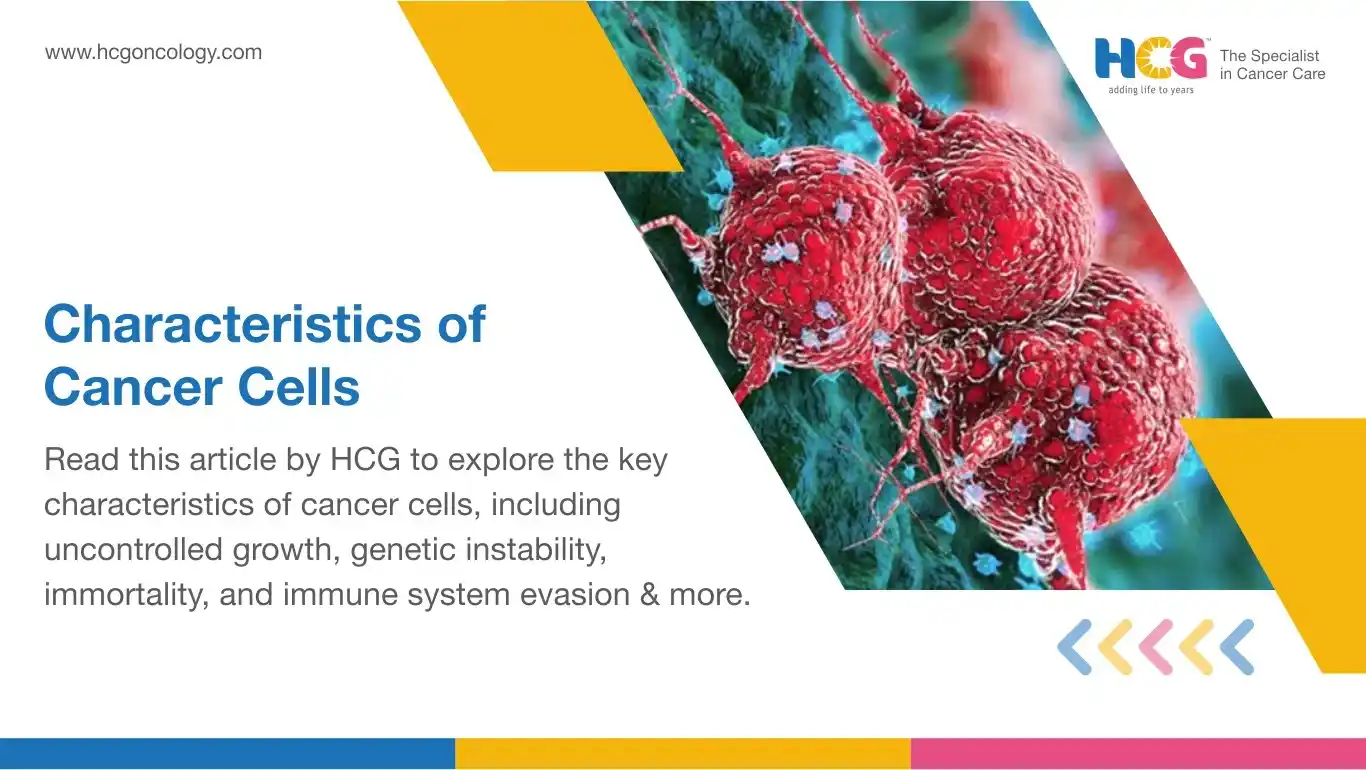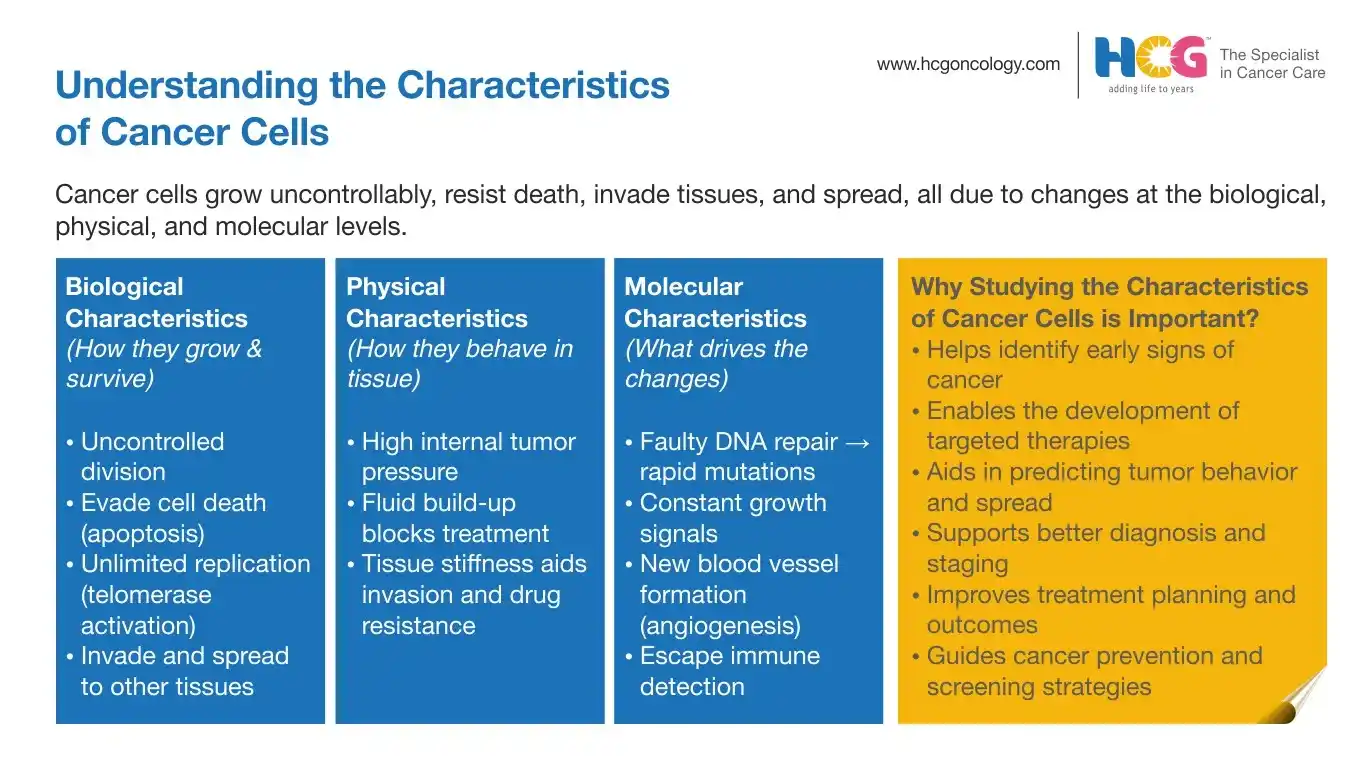
07 Nov, 2025
Feel free to reach out to us.

07 Nov, 2025

This article is medically reviewed by Dr. Chandrasekhar Prasad Singh, Consultant - Medical Oncology, HCG-Abdur Razzaque Ansari Cancer Hospital, Ranchi.
The characteristics of cancer cells differ from normal cells in the body in many ways.
Normal cells become cancerous when a series of mutations (changes) leads the cells to continue to grow and divide out of control.
Unlike normal cells that remain in the region where they began, cancer cells can both invade nearby tissues and spread to distant regions of the body.
Different risk factors or possible causes of cancer may have an impact on how cancer cells divide or exhibit other characteristic features.
Phenotypic characteristics of cancer cells include biological, physical, and molecular traits that allow them to divide uncontrollably, resist death, and invade other tissues.
Common properties of cancer cells include:
Additional Reading: What is Cancer? Types, Symptoms & Treatments | HCG Oncology

Cancer cells display several distinct biological characteristics that set them apart from normal cells.
These traits contribute to their uncontrolled growth, survival, and ability to spread throughout the body.
Uncontrolled proliferation (multiplication) and growth are biological characteristics of cancer cells. Cancer cells bypass normal regulatory mechanisms of the cell cycle.
They continue to divide even when there are no signals to promote growth, often due to mutations in proto-oncogenes (genes that control the growth, division, and survival in normal cells) or loss of tumor suppressor genes (genes that prevent abnormal cell division).
Normal cells undergo apoptosis (programmed cell death) when damaged or no longer needed.
Cancer cells develop mechanisms to resist apoptosis, allowing them to survive even with severe DNA damage or stress.
Overexpression of proteins that prevent cell death and mutations in genes that promote cell death lead to abnormal division of cancer cells.
Normal cells can only divide a limited number of times due to the shortening of their telomeres.
Cancer cells activate the enzyme telomerase, which maintains telomere length and allows for unlimited cell division. This grants the tumor the ability to grow indefinitely.
Cancer cells gain the ability to invade nearby tissues and spread to distant organs. They produce enzymes that degrade the surrounding tissue and enable movement.
Cancer cells show distinct physical characteristics compared to normal cells.
These differences are visible under a microscope and contribute to the aggressive behavior of tumors. Here are the key physical characteristics:
When cancer cells grow quickly in a tight space, they create high pressure inside the tumor.
This solid stress pushes on nearby tissues and blood vessels and makes it harder for blood and medicine to reach the cancer.
It can change the shape and behavior of cancer cells, making them more aggressive.
This refers to pressure built in the space between cells and blood vessels. This commonly occurs in solid tumors.
This pressure exerted on nearby tissues and blood vessels, blocks blood flow, making it hard for oxygen or medicine to reach the tumor.
Tumors often feel hard or stiff compared to normal tissue. This stiffness is caused by a thicker surrounding material (extra proteins and collagen).
Changes in how cells stick to and pull on their environment are also a reason. High stiffness can cause faster cancer cell growth. It helps cancer cells invade more easily and makes tumors resist treatment.
Cancer cells may behave differently from normal cells largely due to changes in their DNA (genes) and the molecules they produce, like proteins. These changes help them grow uncontrollably, avoid death, and spread.
Cancer cells often lose the ability to repair DNA damage.
This leads to even more mutations, helping the cancer grow and become resistant to drugs.
Cancer cells bypass normal cell cycle controls.
They may also produce their own growth factors or become overly responsive to normal growth factors, which can lead to uncontrolled division of abnormal cells.
Cancer cells need nutrients to grow, and these nutrients come from the blood supply. As the disease progresses, cancer cells will need more nutrients and therefore may produce molecules that stimulate the formation of new blood vessels.
In most cases, our immune system can identify abnormal cells and kill them to prevent cancer formation.
However, in some cases, cancer cells can hide from immune cells or shut down immune responses, allowing for uncontrolled division and tumor formation.
Additional Reading: Is Cancer Genetic? | HCG Oncology
Cancer cells differ significantly from normal cells in their behavior, structure, and molecular makeup. These differences are what allow them to grow uncontrollably, avoid destruction, invade surrounding tissues, and spread to other parts of the body.
From a biological standpoint, cancer cells resist death, divide endlessly, and invade other tissues. Physically, they exert abnormal pressure, appear disorganized, and become stiffer than normal cells. At the molecular level, mutations, altered signaling, and changes in gene expression drive their survival and spread.
Together, these biological, physical, and molecular characteristics create a tumor environment that supports cancer progression, calling for a comprehensive and personalized treatment plan that aims at mitigating or controlling the growth of cancer cells.
Understanding these traits is essential for developing better diagnostic tools, more effective therapies, and, ultimately, strategies to prevent and stop cancer growth.

Dr. Chandrashekhar Prasad Singh
Consultant - Medical Oncology
MBBS, MD (Medicine), DNB (Medical
Oncology)
Dr. Chandrashekhar is an experienced medical oncologist who specializes in the management of breast, thoracic, and GI tract malignancies. He is available for consultation at HCG-Abdur Razzaque Ansari Cancer Hospital, a leading cancer hospital in Ranchi. He graduated with an MD degree and a gold medal and has multiple publications in medicine in renowned Indian and international journals. His approach to cancer care is patient-centric, and he strives to provide the best care possible for his patients.
Appointment Link: To Book an Appointment with Dr. Chandrashekaar Prasad Singh.
